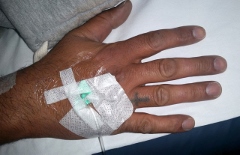(BMJ)—A 46-yo man was found in a sauna, minimally responsive. On arrival to the ED, he was alert. He recalled sniffing an “herbal” bottle, followed by nausea, dizziness, poor balance, inability to stand, SOB, palpitations, sweating, and confusion. Exam: HR 134, BP 108/68 mmHg, RR 32, T 36.3°C, pulse-ox sat 85% on room air, 93% on 15 L/min O2. Skin/lips: cyanotic. What is the dx?
You are correct. Alkyl nitrite-induced methemoglobinemia from sniffing “poppers” was diagnosed. ABG on O2 showed methemoglobin (MetHb) 39%, COHb 0.5%, pO2 272 mmHg, pCO2 36 mmHg, pH 7.36, base excess −4.7 mEq/L, bicarb 20.8 mEq/L, lactate 34.2 mg/dL. MetHb is deeply pigmented, causing central and peripheral cyanosis w/ chocolate brown-colored blood. Increasing levels result in dizziness, weakness, headache, dyspnea, and syncope. Methemoglobinemia can be confused w/ carbon monoxide or cyanide poisoning. Carbon monoxide poisoning usually causes pallor except in cases of excessive exposure, when a cherry-red skin color can occur, as in cyanide poisoning. Both usually cause bright red blood and normal pulse-ox O2 sat readings.
Tx of methemoglobinemia w/ methylene blue is advised if symptomatic or when MetHb level is >25%. Methylene blue can cause local burning pain on injection and interferes w/ pulse-ox readings, resulting in falsely depressed O2 sat values. The pt was treated w/ methylene blue 2 mg/kg IV. Pulse-ox sats dropped to 70% during infusion, and he became even bluer in color due to the methylene blue itself. Five minutes after infusion was completed, pulse-ox reading was 99%. The pt’s color turned pink, and he felt better. His arterial blood turned back to red. However, following tx, his urine turned blue.
Emerg Med J 2016;33:896


